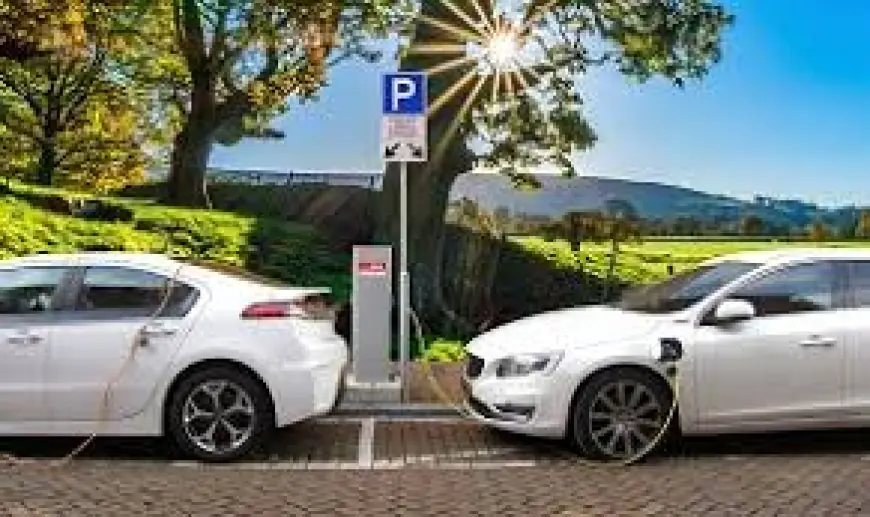Alternative Fuel Vehicle Market 2030 Competitive Landscape
The AFV market is the heightened awareness of environmental issues and the corresponding regulatory measures being implemented globally.

Introduction
The global automotive industry is undergoing one of the most significant transformations in its history, driven by the urgent need to combat climate change, reduce greenhouse gas emissions, and transition towards sustainable energy solutions. At the forefront of this transformation lies the Alternative Fuel Vehicle (AFV) market, a dynamic and fast-evolving sector encompassing electric vehicles (EVs), hybrid electric vehicles, hydrogen fuel cell vehicles, compressed natural gas (CNG) vehicles, and methanol-powered vehicles, among others.
According to industry estimates, the Global Alternative Fuel Vehicle Market reached a value of USD 358.21 billion in 2023 and is projected to grow at a CAGR of 15.25% during 2025–2029. This rapid growth is supported by a combination of government regulations, consumer preferences, and technological advancements.
AFVs are not just a niche innovation anymore—they represent the future of transportation, offering cleaner, more efficient, and environmentally responsible alternatives to traditional internal combustion engine (ICE) vehicles.
Market Growth Drivers
The global shift toward AFVs is influenced by several interlinked growth drivers:
1. Rising Environmental Awareness
With escalating concerns over climate change, global warming, and deteriorating air quality, consumers and governments alike are becoming increasingly conscious of the need for sustainable mobility. AFVs significantly reduce tailpipe emissions, helping to mitigate environmental degradation.
2. Stringent Emission Regulations
Countries around the world are implementing strict emission norms such as the Euro 7 standard in Europe, Corporate Average Fuel Economy (CAFE) standards in the U.S., and China VI in Asia. These regulations encourage automakers to invest in AFV production and phase out high-emission ICE vehicles.
3. Government Incentives and Subsidies
Many governments are offering tax credits, rebates, and subsidies for purchasing AFVs. Policies such as reduced road tax, toll exemptions, and grants for charging infrastructure development further enhance adoption rates.
4. Technological Advancements
Rapid improvements in battery technology, charging infrastructure, and hydrogen fuel cell efficiency have addressed many of the limitations that previously hindered AFV adoption. Battery costs are steadily declining, making EVs more affordable for mainstream consumers.
5. Energy Security and Diversification
AFVs help nations reduce dependency on imported petroleum, enhancing energy security. Utilizing locally available renewable energy sources, natural gas, and biofuels strengthens energy independence.
Download Free Sample Report: https://www.techsciresearch.com/sample-report.aspx?cid=20494
Emerging Trends in the Global AFV Market
The AFV sector is rapidly evolving with multiple innovations and industry trends shaping its future.
1. Electrification Across All Vehicle Segments
Once limited to passenger cars, electrification is now expanding to commercial trucks, buses, two-wheelers, and even heavy-duty off-road equipment. Electric buses are gaining traction in public transport, while electric trucks are being adopted in logistics and freight operations.
2. Solid-State Battery Technology
Solid-state batteries promise higher energy density, faster charging, and enhanced safety compared to conventional lithium-ion batteries. Multiple automakers are investing heavily in bringing this technology to mass production.
3. Hydrogen Fuel Cell Expansion
Hydrogen fuel cell vehicles (FCEVs) are gaining importance for long-haul transport and heavy-duty applications where battery solutions may be impractical. Japan and South Korea are spearheading FCEV adoption alongside growing investments in hydrogen refueling networks.
4. Smart and Connected AFVs
The integration of IoT, AI, and telematics in AFVs is enhancing predictive maintenance, energy efficiency, and user experience. Connected AFVs can optimize energy consumption, provide over-the-air software updates, and enable autonomous driving capabilities.
5. Charging Infrastructure Growth
The development of ultra-fast charging stations, wireless charging pads, and vehicle-to-grid (V2G) systems is improving convenience for EV owners and supporting grid stability.
6. Use of Sustainable Materials
Automakers are increasingly adopting eco-friendly materials in vehicle manufacturing, such as recycled plastics, bio-based composites, and lightweight alloys, to further reduce the overall carbon footprint.
Segment Insights
Electric Vehicles (EVs)
The EV segment remains the fastest-growing within the AFV market. The availability of diverse models, improved driving ranges, and declining battery prices are fueling adoption. EVs are particularly attractive for urban mobility due to zero tailpipe emissions.
Compressed Natural Gas (CNG) Vehicles
CNG-powered vehicles are widely adopted in public transport fleets, taxis, and delivery vehicles. They offer lower fuel costs and significantly reduced emissions compared to petrol or diesel vehicles.
Methanol-Powered Vehicles
Methanol-based transportation solutions are gaining attention due to their renewable production potential from biomass and CO₂. They provide an alternative route to carbon neutrality, especially in regions lacking electric infrastructure.
Hydrogen Fuel Cell Vehicles
Hydrogen vehicles provide long driving ranges and quick refueling, making them suitable for heavy-duty trucks and intercity buses. Investment in green hydrogen production is accelerating their market potential.
Regional Market Overview
North America
Driven by regulatory support, technological innovation, and consumer demand for EVs and hybrids. States like California are leading in charging infrastructure deployment.
Europe & CIS
Stringent carbon-neutrality targets and emission regulations are pushing mass adoption of EVs, plug-in hybrids, and hydrogen vehicles. Norway, Germany, and the UK are leading markets.
Asia Pacific
Emerging as the largest AFV market, powered by rapid urbanization, strong government support, and the dominance of China in EV manufacturing.
South America
Brazil and Chile are seeing rising EV adoption, driven by clean energy initiatives and renewable energy integration.
Middle East & Africa
Gradual adoption of AFVs, with government-led initiatives in UAE, Saudi Arabia, and South Africa focusing on infrastructure development.
Industry Key Highlights
- Market Size (2023): USD 358.21 Billion
- Forecast CAGR (2025–2029): 15.25%
- Fastest-Growing Segment: Electric Vehicles
- Primary Growth Regions: Asia Pacific, Europe
- Key Drivers: Environmental regulations, technological advancements, government incentives
- Major Challenge: High initial cost and limited infrastructure
- Opportunities: Hydrogen fuel cell adoption, solid-state batteries
- Market Leaders: Tesla, BYD, Toyota, Volkswagen, BMW, Hyundai, Ford, Mercedes-Benz
Competitive Analysis
The AFV market is highly competitive, with both legacy automakers and new entrants striving for market share. Companies are competing on technology, range, charging speed, and affordability.
- Tesla Inc. – Global EV leader with strong brand recognition and proprietary charging infrastructure.
- BYD Company Limited – Dominant in China’s EV and electric bus markets, expanding globally.
- Volkswagen AG – Aggressive electrification strategy with the ID series of EVs.
- Toyota Motor Corporation – Leader in hybrid technology and advancing hydrogen fuel cell vehicles.
- BMW AG – Expanding electric and plug-in hybrid lineup under the BMW i series.
- Hyundai Motor Company – Pioneering hydrogen mobility with NEXO fuel cell SUV.
- Ford Motor Company – Gaining ground with electric trucks like the F-150 Lightning.
- Mercedes-Benz Group AG – Luxury EV offerings and commitment to carbon-neutral production.
Future Outlook
The future of the Alternative Fuel Vehicle market is undeniably promising. By 2030, AFVs are expected to capture a significant share of global vehicle sales, driven by declining battery costs, increased charging coverage, and policy-driven incentives.
Key developments to watch include:
- Mainstream adoption of solid-state batteries.
- Rapid growth in hydrogen infrastructure.
- Expansion of V2G technology enabling AFVs to act as mobile energy storage units.
- Affordable entry-level EVs targeting mass-market adoption in developing economies.
As automakers, governments, and technology providers collaborate, the AFV market will play a pivotal role in achieving global sustainability targets.
10 Benefits of the Research Report
- Comprehensive market size and forecast data for informed decision-making.
- Detailed analysis of key growth drivers and emerging market trends.
- Competitive landscape mapping of top global AFV manufacturers.
- Segmentation insights by fuel type, vehicle type, and region.
- Evaluation of current and future technological advancements.
- Regional market analysis highlighting growth hotspots.
- Identification of challenges and strategic solutions.
- Market opportunity assessment for investors and stakeholders.
- Future outlook supported by reliable data projections.
- Actionable recommendations for market entry and expansion strategies.
Contact Us-
Mr. Ken Mathews
708 Third Avenue,
Manhattan, NY,
New York – 10017
Tel: +1-646-360-1656
Email: [email protected]
Website: www.techsciresearch.com
What's Your Reaction?
 Like
0
Like
0
 Dislike
0
Dislike
0
 Love
0
Love
0
 Funny
0
Funny
0
 Angry
0
Angry
0
 Sad
0
Sad
0
 Wow
0
Wow
0


















































